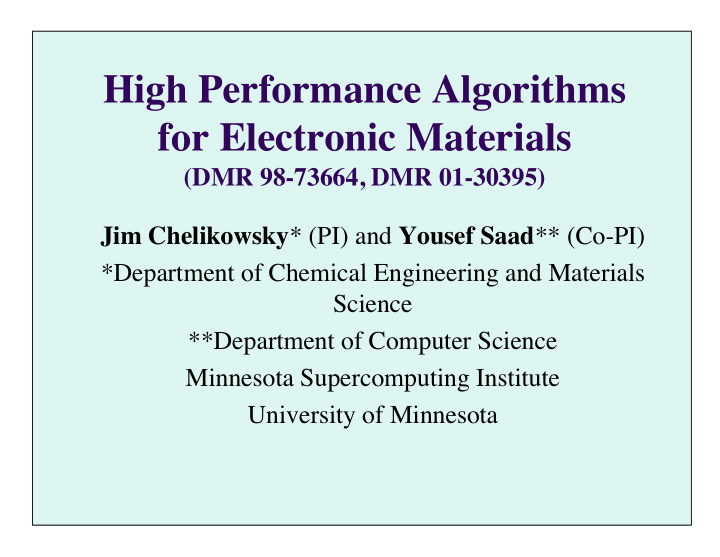



High Performance Algorithms for Electronic Materials (DMR 98-73664, DMR 01-30395) Jim Chelikowsky * (PI) and Yousef Saad ** (Co-PI) *Department of Chemical Engineering and Materials Science **Department of Computer Science Minnesota Supercomputing Institute University of Minnesota
Goals of Our Research Program • The focus of our research is to exploit high performance computers for solving large scale and complex problems that arise in modeling real materials. • Our planned research efforts will center on electronic materials in the form of complex solids, atomic clusters, liquids, and glasses. • The means to accomplish this research will be based on a strong interdisciplinary program between computational and physical scientists.
Program Overview • Research Highlights – Algorithm Developments – Applications to Materials • Defects • Liquids • Clusters/quantum dots – Recent Publications • Personnel, facilities, outreach
Algorithm Developments • Real space description of pseudopotentials constructed with density functional theory (J.R. Chelikowsky, N. Troullier, and Y. Saad, Phys. Rev. Lett. 72, 1240 (1994)) -Powerful approach: easy to implement on parallel platforms, ideally suited for localized systems. • Advances in algorithms – Developed parallel finite difference code for real-space electronic structure problem • Structural energies, vibrational spectra • Ab initio molecular dynamics • Polarizabilites, dielectric response • Time dependent density functional theory – Parallel eigenvalue codes on various machines (Davidson) – Demonstrated the possibility of eigenvector-free methods in self consistent calculations. – Optimized the code for the IBM SP and other platforms
EXAMPLES OF APPLICATIONS •Defects: Structure, energy levels •Clusters: Polarizablity, photoemission, structure •Quantum dots: Optical excitations, role of surface passivation, quantum confinement •Liquids: Structure, electronic and optical properties, diffusion
Divacancy in Silicon • Watkins using spin resonance methods proposed a model for explaining electronic energy levels in 1965 based on large Jahn-Teller (JT) distortion. • Previous theoretical work was not consistent with his model. Our work is consistent. • Only if large (more than a hundred atoms) systems are considered can one replicate his model. Model of Divacancy • Real space methods and new computational platforms have allowed us to examine such size regimes. Calculated structure showing large JT distortion Energy structure levels and structure proposed by Watkins
Photoemission and Polarizabilities of Electron Yield (arb. Units) - Si 6 Localized Systems Theory Expt. -5 0 Energy (eV) Prior density functional theory calculations for the polarizability of Na Compared calculated “density of states” clusters have been at variance with experiment. from ab initio simulations have suggested Using finite temperature ab initio molecular that cluster anions are often not in the dynamics simulations, we resolved this ground state. We proposed a new “rule” discrepancy. for predicting the observed spectra.
Optical Properties of Localized Systems Implemented time dependent density functional theory to predict the role of quantum confinement in clusters (Si, GaAs, CdSe) and quantum dots. Quantum dot Comparison of calculated gaps from TDLDA to small hydrogenated molecules and Example of quantum confinement quantum dots.
Electronic and Structural Properties of Semiconductor Liquids •First studies of II-VI and IV-VI liquids. - GeTe liquid shows anomalous “reentrant” Peierls Distortion - CdTe prediction of optical conductivity as function of temperature Optical conductivity of liquid GaAs and CdTe. GaAs is a metal in the melt; CdTe is a semicondcutor Ab initio simulation of liquid CdTe
Recent Publications • Defects in solids: Divacancy in Silicon – S. Ogut and J.R. Chelikowsky, Phys. Rev. Lett. 83 , 3852 (1999). • Liquid semiconductors: Optical and Structural Properties of Liquids – V. Godlevsky, et al., Phys. Rev. Lett. 81 , 4959 (1998). – J.Y. Raty et al., Phys. Rev. Lett. 83 , 3852 (2000). • Optical and collective excitations in clusters, quantum dots and complex solids: – I. Vasiliev, S. Ogut and J.R. Chelikowsky, Phys, Rev. Lett. 82 , 1919 (1999). – J. Muller, et al., Phys. Rev. Lett. 85 , 1666 (2000). – I. Vasiliev, S. Ogut and J.R. Chelikowsky, Phys, Rev. Lett. 86 , 1813 (2001). – L. Kronik, et al., J. Chem. Phys. 115 , 4322 (2001). – J. Woicik, et al., Phys. Rev. Lett. (2002), in press.
Future Research Directions • Algorithms – Developing out-of core methods for the real-space method using polynomial filtering, eliminate eigenvalue problem. – Implement real space methods with periodic boundary conditions – Investigate techniques for reducing cost of time dependent density functional theory using different algorithms. • Physical Science – Spintronics systems (magnetic semiconductors, GaMnAs, GaMnN, GaMnP): extended systems and quantum dots – Optical excitations in dots, clusters and molecular systems (Green Function, time dependent density functional theory) – Complex fluids and defects – Full dielectric matrix calculations for localized systems
Personnel Graduate Students Physics: Eunjung Ko and Vitaliy Godlevsky (PhD, 99) Materials Science: Igor Vasiliev (PhD, 00), Manish Jain (PhD, 02), Shen Li Chemical Physics: Claudia Troparevsky Scientific Computation: Russ Burdick (MS, 02) Computer Science: Luis Yunes, Yu Liang, Laurent Smoch Postdoctoral Fellows Leeor Kronik, Manuel Maria Gonzalez Alemany, Emmanuel Lorin, Tajendra Vir Singh
Group at Minnesota Left to right: First row- Russ Burdick and Leeor Kronik. Second row- Shen Li, Claudia Troparevsky, Eunjung Ko, Manish Jain and Yousef Saad.
Facilities and Programs at Minnesota • Digital Technology Center – Supercomputing Institute for Digital Simulation and Advanced Computing • MRSEC (Magnetic Heterostructures) • IGERT ( Nanoparticle Science and Engineering)
Web Sites • Software site http://www-users.cs.umn.edu/~saad/software.html – Codes: SPMATH, SPARSKIT, Sparse matrix computations. • Research http://jrc.cems.umn.edu/ – Preprints, reprints and codes (PARSEC) real space pseudopotential; molecular dynamics and time dependent density functional theory.
Recommend
More recommend